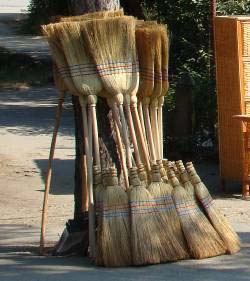Fall Cleanup: Plant Placement and Pesky Problems

Fall cleanup of Sage plants usually isn’t demanding but varies from one region to another depending on local climate. It’s also affected by the characteristics of individual species, conditions of home landscapes and past difficulties with diseases and predators.
True Sages (Salvia spp.) form the largest genus in the mint family and may contain up to 900 species in a wide variety of environments, including hot desert lands, humid coastal plains, and cool mountain settings. Growing a particular species in the wrong yard location or climate can make it less vigorous and more susceptible to problems, including attacks by insects and fungi.
That said, Salvias are known for their hardiness and adaptability. Aside from resisting disease and predators, they often show a mulish penchant for thriving in USDA Plant Hardiness Zones for which they aren’t recommended.
Becoming Savvy About Salvias
Cleanup can involve moving or even saying goodbye to a favorite Salvia. You may become aware that a plant you selected is wrong for the temperatures and conditions of your region. The best solution may be to do some research and replace it with another, more zone-appropriate species in the next growing season. Or it may become apparent that you need to relocate an ailing sage to a sunnier or shadier yard location.
However, Salvias are fortified against attack if planted where drainage, sunlight, moisture, and temperatures are right for them. Keep in mind that conditions such as excessive humidity or aridity as well as extreme heat or cold may increase your seasonal upkeep of Salvias in order to avoid predators and diseases that take advantage of plants weakened by their growing conditions.
Fall Upkeep by Species
Although Salvia species share a number of characteristics, such as long bloom times and fragrant foliage, their upkeep and success may depend on you understanding their differences. For example:
• Bog Sage (Salvia uliginosa) tolerates damp roots, but most Salvias prefer dry, well-drained soil. Autumn upkeep of these drier species may include digging in extra organic matter, builder's sand, and peat to keep water from getting trapped around roots and freezing.
• Despite drought resistance and a general sun-loving nature, some Salvia’s — such as Red Velvet Mountain Sage (S. microphylla ‘Red Velvet’) — need some shade and deep watering in arid climates. Without it, they may be more prone to attack by pests, such as spider mites, that thrive on plants shocked by dry heat. Keep your Salvia’s branches clean of insects by spraying them with slightly soapy water until winter takes care of these pests.
• Most Salvias begin blooming by summer at the latest, but the shade-loving Scandent Mexican Sage (S. iodantha) doesn’t get going until the cooler months of autumn and continues flowering through December. So trimming it back in autumn would mean a loss of rare winter color in areas where temperatures stay above 20 degrees F.
Getting Rid of Unwanted Guests
As Salvias age, they may be subject to fungal diseases, especially in warm, humid areas. These maladies include downy mildew and verticillium rot. During autumn cleanup you can avert a spring resurgence of fungal diseases by increasing aeration. This requires thinning woody species or dividing and replanting herbaceous Salvias. Don’t forget to remove decaying flower spikes where fungi can thrive.
If predatory insects that love Salvias – such as aphids, spider mites and whiteflies — have been a problem during the growing season, cleaning up leaf litter during autumn will eliminate their winter habitat. Fortunately, Salvia’s seem to thwart many fungal diseases and unwanted pests. If yours haven’t suffered from these problems, allowing their leaf litter to decay on the ground will nourish the soil and future plant growth.
Bitter Taste and Broken Rules
Salvia health and lack of predators may be due largely to the volatile leaf oils and other chemicals they contain. Researchers think these compounds may smell or taste bad to wildlife, including insects.
Another benefit of planting Salvias, as previously mentioned, is that they may surprise you by breaking rules. Sometimes species recommended for warm zones do beautifully in cold areas due to beneficial placement in yards, such as along wind-sheltered, sunny walls.
Beneficial placement is necessary even if Salvias are growing in a zone identified as being appropriate. Vigor may depend on receiving more or less sunshine and more or less moisture. Your research and previous growing experiences can help you identify good planting spots.
Need Information?
Whether you have questions about our plants or about Salvia gardening in general, please contact us at FBTS. We'll help you grow a beautiful landscape.

 Salvia iodantha
Salvia iodantha  Salvia microphylla 'Red Velvet'
Salvia microphylla 'Red Velvet'  Salvia uliginosa
Salvia uliginosa
Comments
There are no comments yet.